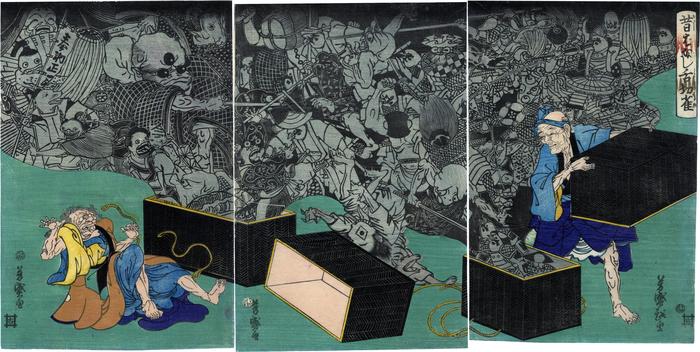Utagawa Yoshimori (歌川芳盛) (artist 1830 – 1884)
Taguchi Sakuzō (family name - 田口作蔵)Ikkōsai (go - 一光斎)
Kōsai (go - 光斎)
Kuniharu (go - 国晴)
Sakurabō (go - さくら坊)
Links
Biography:
Little is known about the life of Yoshimori, other than he was born Taguchi Sakuzō in 1830 and died in either 1884 or 1885. He was a student of Utagawa Kuniyoshi (1798-1861), one of the most successful woodblock print designers in Edo, and used multiple artist names as listed above. He lived in the Edo districts of Shitaya-hirokōji (now Ueno-hirokōji) and then moved to Ikenohatakayacho. [Hirokōji or 広小路 means 'wide main street'.] Some sources, including the wikipedia Japan site, say that he was a member of the Japanese Diet and resigned either in 1884 or 1885. Other sources make no mention of this. Towards the end of his life he moved to Yokohama.
He designed both woodblock prints and illustrated books. As well as producing images of Yokohama, he designed kachoga, musha-e, yokohyama-e, giga and works of political satire such as the below pictured 1864 print Tongue-cut Sparrow (Shita-kiri suzume). He contributed over a dozen prints to the famous series Scenes of Famous Places along the Tōkaidō Road (Tōkaidō meisho fūkei), also known as the Processional Tôkaidô (Gyōretsu Tôkaidô.) The influence of Kuniyoshi is clear in many of his works. He designed over thirty books, many of them song and humorous poetry books.
From: A Dictionary of Japanese Artists: Painting, Sculpture, Ceramics, Prints, Lacquer, Laurance P. Roberts, Weatherhill, 1976, p. 202-203; The Hotei Encyclopedia of Japanese Woodblock Prints, Amy Reigle Newland, Hotei Publishing Company, 2005, p. 505.
